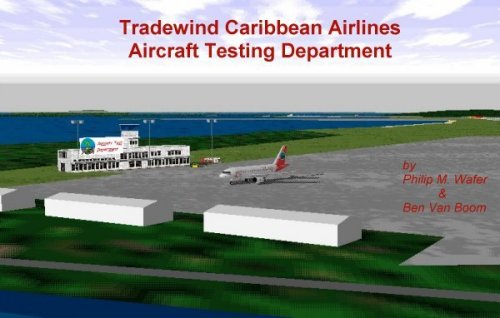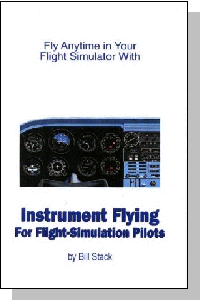

Below is a quick review of Bill Stacks' "Instrument Flying for Flight Simulator Pilots"

This book is around 110 pages in total and has the express
purpose to teach you to "Fly anytime in your Flight
Simulator with...". It is about A5 in size and costs
US$14.95. Check out HTTP://WWW.TOPSKILLS.COM/IF.HTM for up to
date information. You can order on-line there also.
Since acquiring his other three titles I've been looking forward
to the promised publishing of this title.
Bill has divided the subject into 7 chapters, a section of
exercises, index and bibliography: The chapters are titled: What
is Instrument flight; Understanding Requirements and
Restrictions; Using your aviation Instruments; Using Charts &
Flight Plans; Planning, Taking off & Departing; Flying En
Route & Holding; Approaching & Landing. As you can see it
is a complete expansion of the chapter 6(Flying IFR) in
"Flight Simulator Pilots' Information Manual"
The usual disclaimer concerning not using the information for
real flying is prominently displayed at the back of the title
page. Heed the warning!
1) What is Instrument Flight? - yes indeed , what IS instrument
flight? Bill explains this in detail and even includes a couple
of paragraphs on What Instrument Flight Is Not!!
2) Understanding Requirements & Restrictions - This chapters
discusses the above with relation to the pilot, the aircraft
equipment, weather, visibility, airspaces, IFR procedures. Bill
finishes the chapter by including a handy checklist for
determining whether you need to fly IFR.
3) Using Your Aviation Instruments - This chapter breaks up
instrumentation into 3 distinct groups - Flight, Navigation &
Aircraft. Its interesting to see the subject broken down like
this as it gives you a different view of what you have on the
panel in front of you and can certainly be helpful in assigning
priorities when scanning your instruments.
On the subject of navigation instrumentation a number of
instrument types are explained including the up-and-coming GPS
systems.
4) Using Charts & Flight Plans - Planning , En Route, STARS,
SIDS and IAPs charts are explained with figures. Many of the
elements of each type are explained and Bill finishes the chapter
with a table of the elements of Flight Plans.
5) Planning , Taking Off & Departing - I find that planning
is very important for any flight and have learnt the hard way
that this is so. This chapter gives everything needed for
complete flight plan. Even down to "Tidy your cockpit!"
I do a lot of the items mentioned - fuelling up correctly for the
flight, set altimeter etc. Tidying up would consist of putting
away anything not associated with this flight and just having the
flight plans, SIDs, STARs, IAPs for the flight laid neatly out on
the table. Other items can be taken care of while at the holding
point e.g. setting autopilot initial altitude hold setting,
Setting NAV radios to first fix etc.
6) Flying En Route & Holding - Definitions, principles and
procedures abound in this chapter. For instance Bill gives
definitions for "Optimum Altitude" and "Teardrop
Turn", and some include figures to help your understanding.
Where holding patterns should take place are also pointed out
with the help of En Route Charts. How to carry out these
procedures are explained also. Flying holding patterns gets about
half the chapter as Bill goes into quite an in-depth explanation
of the procedure.
7) Approaching & Landing - Yes, the end of the flight. Its
amazing how much you rely on your instruments for this phase. If
you want to get it right, that is!! So what is an Approach, a
Landing. Definitions are in the first paragraph of this chapter.
Instrument Approach Procedure charts are used as illustrations
for this subject. Different types of Approach are discussed and
even the approach is broken down to its' different segments.
There are plenty of technical details in this chapter covering
every aspect of approach and landing e.g. Minimum Descent
Altitude, Missed Approach Point, Approach Lights, Aircraft
Approach Categories, Approach Speeds, to name but a few.
Appendix: Instrument Flight Exercises: There are six exercises in
this section with a weather table at the front. The weather table
is divided into 4 columns - Condition, 1st series, 2nd series
& 3rd series - the idea being to do the Instrument Flight
exercises 3 times under the three different weather settings, the
first being the easiest etc. Mind you, the first weather setting
is for a ceiling of 1500 feet. I took this to mean a cloud base
of 1500 feet! Tops is 10000 feet. So...the first exercise is
instrument take-off with an en route altitude of 3000 feet. That
means you are cruising IN the clouds. A bit of disorientation is
certainly involved at first when you have to turn back to your
point of departure. As Bill says in the first chapter,
"According to IFR training manuals, noninstrument pilots
become disoriented within minutes of losing visual reference to
the ground."!
I can't say that I've used the weather settings much in my Flight
Simulator but if you use the recommended settings for the
exercises, and I include the "easy" weather setting in
the table, you are FORCED to concentrate on the instruments. I
have tried the first exercise and have found this to be the case.
This is great, and certainly gets you working! The section also
includes all the charts you need to complete the exercises.
Well, Bill didn't let me down with his book! There is plenty of
detail of the right level to get me flying my Flight Simulator
one step nearer "as real as it gets" (to quote MS).
I especially liked the exercises, as you may have determined from
the above paragraphs. They dump you right in at the sharp end
where you are forced to use the instruments. You can't see very
much when you are in the clouds! When you are clear of them, a
visibility limit of 2 miles is nothing at 90 knots!!!! Which way
to Bridgeport??
Now...I must get a shelf to place the books for easier retrieval!
Philip M. Wafer
Dublin, January 1998